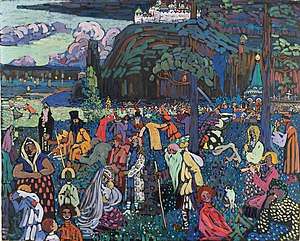Emanuel Lewenstein
Emanuel Albert Lewenstein (5 December 1870 – 10 June 1930)[1] was a Dutch art collector.
Early life
Emanuel Albert Lewenstein was born in Amsterdam on 5 December 1870, the son of Adolph Lewenstein and Lea Joachimsthal.[1]
Kandinsky's Das Bunte Leben

Lewenstein bought Wassily Kandinsky's oil painting Das Bunte Leben (The Colourful Life) immediately after it was created in 1907. After his death, his widow Hedwig loaned it to Amsterdam's Stedelijk Museum for safekeeping.[2]
On 3 March 2017, three of his heirs filed suit in New York City against Bayerische Landesbank who believe they now own it, in respect of the painting, now valued at $80 million.[2][3]
The lawsuit claims that the painting was effectively taken and sold without permission, "The painting was taken from its legitimate owners in 1940 in violation of international law during the period of the Nazi occupation in the Netherlands in furtherance of the Nazi campaign of Jewish genocide".[3]
Das Bunte Leben is on show at the Städtische Galerie im Lenbachhaus, in Munich, Germany.[3]
Personal life
On 11 March 1901 in Bonn, Germany, Lewenstein married Hedwig Weyermann (11 Oct 1875 Bonn, Germany - 20 May 1937, Amsterdam), the daughter of Gottschalk Weyermann and Mina Oppenheimer.[1]
They had two children:[1]
- Robert Gotschalk Lewenstein (30 Oct 1905, Amsterdam - 1975 Blue Creek, Ohio, US), who married Henriëtte Ruth Opprower
- Wilhelmina Helena Lewenstein, who married José Augusto Da Silva
References
- "Emanuel Albert LEWENSTEIN". DutchJewry.org. Retrieved 4 March 2017.
- Watt, Holly (3 March 2017). "Bank's Kandinsky painting was looted by Nazis, says family". The Guardian. Retrieved 4 March 2017.
- Moynihan, Colin; Smale, Alison (2 March 2017). "Heirs Sue for Return of a Kandinsky, Saying It Was Looted by Nazis". The New York Times. Retrieved 4 March 2017.